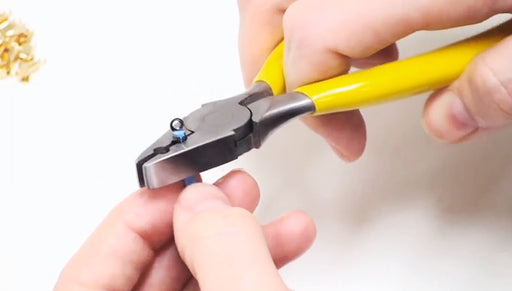
|
Brass Gauge Caliper Measure & Convert Inches/Metric SKU: XTL-9040 $5.99 |

|
Beadalon Beading Mats - Prevent Bead Rolling 12 x 9 Inch (Set of 3) SKU: XTL-9930 $3.99 |
Welcome to Beadaholique.com's Learn to Bead Video Series, an ongoing series were we explore the basics of creating your very own beaded jewelry. This is our first installment in which we will cover the basic types, shapes and sizes of beads. Now beads come in almost an infinite variety of types and shapes and colors. So we tried to narrow it down the scope a bit and start with the kinds more typically used in everyday beading projects. First there are two general material categories people fall into: man made or natural. Man made can mean anything to bead fabricated from a man made material such as plastic lucite, crystal, glass, porcelain and ceramic and metal. Natural beads or any beads that created from materials found in nature. These beads can be made from wood, seeds and nuts, stone, pearls or any other natural material. Now we're gonna move onto the various shapes of beads. The first and most obvious shape is round. Here we have a bicone, which is two conical shapes joined at the base to make one solid shape. This is a rondelle also called a roundelle and it's just a round, slightly flattened. These are all spacer beads and a flat little disc beads that go in between larger beads to space out your design. Here we have some tube beads also called noodle beads. This is a square. This a disk. Rectangular. This is a barrel bead which is like a oval except flattened at the top and bottom. Down here we have some natural stone shape. And here are a bunch of chips. A lot of gemstone come in chip shapes. This is a tear drop. And this bead is kind of puff shape, this is a puff rectangle but it can also come in in a round shape. When it's circular it can also be referred to as a lentil 'cause it's shaped like a lentil. Oval. Cabochon which is any bead that does not have a hole in it. It's gonna be glued to a finding or a piece of material and bead it around. Seed beads which are used for beadwork and innumerable other geometric and novelty shapes. Finally we're gonna talk about bead size. Beads can be extraordinary tiny, such as seed beads or they can get quite large esspecially when you're dealing with focal beads or pendants. These are generally measured in millimeters. For those of you not raised using the metric system, one inch contains about twenty five and a half milliliters. One device that I always have close at hand when beading. This is a ultra handy little brass gauge. It's perfect for sizing up beads are converting inches to metric. Also good to have on hand are these coins just for reference. So you can size them up and you can always know that a nickel is twenty one millimeters, a dime it's eighteen millimeters and a quarter is twenty four millimeters. A quarter is just under an inch. Here we have all the various sizes of beads all in round shapes. This is a two and a half millimeter, three, four, five millimeter, six millimeter, skipping seven cause seven isn't as common, here's an eight millimeter, nine millimeter, ten millimeter, there's a twelve millimeter, and a fourteen millimeter. So that's it for introduction to the wonderful world of beads. I hope you learned a lot you were inspired to start creating. Please join us next time when we explore findings. Go to Beadaholique.com for all of your beading supplies needs!
Related Videos


How To Use A Bead Stopper
The Bead Stopper secures the end of your project and makes working with beads easy. It's simply amazing because it's amazingly simple! No more acci...
View full details

How to Use Foldover Crimps
In this video, Beadaholique's Andrea shows us how to use foldover crimps. Foldover crimps are used on the ends of cords or ribbon to attach clasps.


How to Do Pearl Knotting Using Tweezers
Learn how easy it is to knot between pearls using Griffin silk thread and tweezers.
Customer Reviews
You recently viewed
Clear recently viewedVideo nicely presented in a simple way. Thank you.
